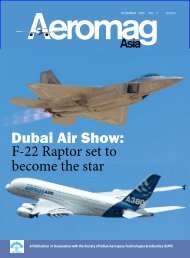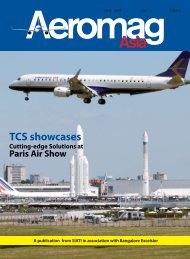July-August 2011 - Aeromag
July-August 2011 - Aeromag
July-August 2011 - Aeromag
Create successful ePaper yourself
Turn your PDF publications into a flip-book with our unique Google optimized e-Paper software.
Will grow rapidly in India,<br />
says Honeywell<br />
Honeywell expects to grow rapidly in India, Mr. Pritam Bhavnani,<br />
President , Honeywell Aerospace India , told Sunny Jerome,<br />
Managing Editor of <strong>Aeromag</strong> Asia, in an exclusive interview.<br />
The company is setting up a research and development centre in<br />
Gurgaon to address its European business. Honeywell currently<br />
has around 12,000 employees in India. A significant amount of<br />
R&D and engineering works, as well as development of aero plane<br />
products are done in Bangalore. Fight control system, avionics and<br />
engine modifications are some of the key areas of development. It is<br />
not like back office work; real work is done in Bangalore. Excerpts<br />
from the interview.<br />
How important is the Indian market<br />
for Honeywell?<br />
It is very important from multiple<br />
points of view. One, obviously, is people’s<br />
talent, skill and capability. It is the very<br />
important part. If you look at the number<br />
of employees Honeywell has, India is the<br />
number two in terms of the headcount<br />
after the US.<br />
The second is obviously the market,<br />
the volume of business that we can have<br />
in India. Honeywell’s revenue in India<br />
is around USD 500 million of the total<br />
revenue of USD 33 billion – USD 34 billion.<br />
So, half of the billion is coming from India.<br />
Not that big now, but we are expecting to<br />
grow very rapidly in the future.<br />
And also we do a lot of exports out<br />
of India – turbochargers for example.<br />
In Pune, we made turbochargers for<br />
companies like Tata and Mahindra. And<br />
also we export them to Thailand, Europe,<br />
and other places. Two years ago, we made<br />
400,000 and 800,000 last year, and this we<br />
will go up to 1.5 million turbochargers in<br />
Pune. So the volume has doubled two<br />
years in a row and most of this being<br />
exported to Thailand and Europe also. It is<br />
all coming out of Pune.<br />
What are the new initiatives coming?<br />
I told you that, in case of turbochargers,<br />
we are growing tremendously. In design<br />
and development engineering, we are<br />
growing tremendously. We are also adding<br />
a new research and development centre<br />
in Gurgaon for our European business,<br />
which is the petrochemical business<br />
where we will be going, what Honeywell<br />
does in Europe.<br />
We actually design the process and the<br />
catalyst that are needed to convert raw of<br />
feed stocks whether it is crude oil and L.G<br />
oil to convert to diesel, kerosene, petrol,<br />
jet fuel etc. That conversion process is<br />
what Honeywell’s knowledge is and we<br />
are experts at that.<br />
So we have done one big centre in US<br />
and we will be setting up one in Gurgaon<br />
this year. Crude oil in Saudi Arabia is<br />
different from the crude oil in Bombay<br />
High and in the US and or in Russia. Each<br />
crude oil has different properties.<br />
What are the new trends you are<br />
seeing in Indian Defence market?<br />
I think Indian Defence market is going<br />
to through certain changes. One of the<br />
elements is modernising of the aircraft.<br />
If you look at the aircraft previously,<br />
the transport aircraft of Russian origin<br />
designed from 70s and 80s that we<br />
purchased. Now the new transport aircraft<br />
which has been purchased C-130, C-70<br />
and they will start taking over the main<br />
responsibility because they are more fuel<br />
efficient, take off and land in a shorter<br />
runway. They don’t need any finished<br />
runway or concrete runway. So there<br />
is the advantage to those aircraft, they<br />
will get more use and there are a lot of<br />
Honeywell components on them. We are<br />
working with the airports to establish the<br />
maintenance requirements, maintenance<br />
facility for Honeywell products.<br />
In Hyderabad, we have done another<br />
R&D centre actually. R&D is a service<br />
centre, one of the key things we provide<br />
from Hyderabad is also, what we call,<br />
Flight support Services. Flight Support<br />
services is for example for the business<br />
aircraft. For these aircraft when they<br />
are planning a flight, let’s say it is going<br />
to fly from Mumbai to Dubai-so we will<br />
from this Hyderabad centre, will get the<br />
information on this date, on this time we<br />
want to leave and this time we will arrive.<br />
So they will then plan out around it, give<br />
them all the view points, identify them,<br />
get all the weather picture, getting all<br />
the clearance while the aircraft is in the<br />
air, to follow them to make sure whether<br />
there is any problem or not.<br />
If there is any problem, they will send<br />
to alternate airport, to book even hotel<br />
to help them. By the time they land,<br />
hotel will already be there and cars<br />
also will be ready to pick them from the<br />
airport, because for these people time<br />
is so precious. One of the main things<br />
is supporting the flights of business<br />
aircraft and that support is done from<br />
Hyderabad for flights all over the world,<br />
not just in India but all over the world.<br />
Business aircraft in the US are also using<br />
Hyderabad centre for this for example.<br />
If you go on air with a good control<br />
from all these big TVs, tracking all flights<br />
in US and Europe, Asia, India and the<br />
different parts of the world, they have all<br />
control over all these people, each one is<br />
monitoring, helping, planning for future<br />
flights of getting clearances and working<br />
with the Airports for landing time and<br />
arrangements<br />
What are you doing on modernization<br />
of Indian Airports?<br />
I will give an idea about what we had<br />
done in Hyderabad and Delhi Airport on<br />
the new terminals. For example: Delhi<br />
Airport T3. All the security systems -- that<br />
means from video camera to the control<br />
room to the badge readers, whether<br />
someone has to put badge to open the<br />
door or close the door before you enter<br />
the airport -- all those badge readers, all<br />
those control system for the full security,<br />
the preliminary security of airport were<br />
done by Honeywell.<br />
All the air conditioning control system,<br />
all the lighting control systems, and the<br />
runway lights are done by Honeywell.<br />
So a lot of equipment into these large<br />
buildings and structures to manage<br />
electricity, energy, and all those things are<br />
done by Honeywell. So Hyderabad airport<br />
is the same thing, Delhi airport is the same<br />
thing, all the new airport coming up, we<br />
are working on Chennai with AAI and will<br />
work like this in future.<br />
What are the short term, medium<br />
term and long term plans?<br />
Short term, obviously continue what we<br />
are doing now, grow and expand. Medium<br />
term would be to do more research,<br />
more development but also not only for<br />
products made and operated in western<br />
world but also new products for India<br />
specifically. Now we are starting to look<br />
at what is needed in India that we can<br />
design in India and make it in India for the<br />
Indian Market. This is a kind of medium<br />
term. Then long term is also when to take<br />
development from both areas -- western<br />
development and Indian development<br />
-- and apply it different places. We call it<br />
“Upon East for East and East for West”.<br />
East for east means India for Indian market<br />
and east for west means the things we<br />
develop for western market.<br />
What’s the update on the human<br />
resources front?<br />
I think it depends upon the business<br />
growth. It is hard to put numbers on that.<br />
In 2002 or 2003, we had 1000 employees<br />
in India, but today we have 12,000<br />
employees in India. That means the<br />
growth rate is quiet good, so based on the<br />
business growth, something like this will<br />
continue. I think there is no resistance on<br />
the part of Honeywell to grow on.<br />
What are the takeaways from Paris<br />
Air show?<br />
Two big very clear announcements we<br />
made, one was on the green fuel. This<br />
fuel was used first to fly from the US to<br />
Europe. It was on Honeywell’s business<br />
jet and it was used to 50-50 random of<br />
normal oil based jet fuel verses the green<br />
fuel. We have the process to convert<br />
this into eco-friendly jet fuel. There are<br />
several advantages of the fuel that we<br />
developed.<br />
All aero planes which use this fuel will<br />
have less carbon emission so they have<br />
to pay less carbon tax. They can save<br />
money this way. And the other thing<br />
in regard to this fuel is that, it is being<br />
tested and certified by ASTM (American<br />
Society of Testing Material). Once it is<br />
certified, then all the refineries can start<br />
producing it, so the oil companies can<br />
start delivering it to airfield use by the<br />
airport.<br />
This fuel has been tested on about 10 or<br />
12 different types of aircraft in different<br />
engines in different parts of the world<br />
like the US, Korea, Japan, and Asia. It<br />
has been tested on Boeing aircraft, Air<br />
force Aircraft, GE engine, Helicopters,<br />
Fighter aircraft of the military. All types<br />
of engines, aircraft, and requirements<br />
are tested for the last 20 years. After all<br />
these thorough testing, it is certified<br />
and now it is ready for the actual use. It<br />
is important from efficiency perspective,<br />
environmental perspective.<br />
Any joint venture?<br />
One we announced with SAFRAN for<br />
electric taxi system, which basically would<br />
take the electric power from observing<br />
power unit and use it to drive the wheels<br />
of the airplane so that there is no need to<br />
turn on the main engine. In India, we don’t<br />
have any joint venture.<br />
A e r o m a g 22<br />
A e r o m a g 23




